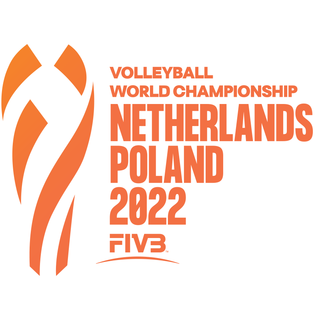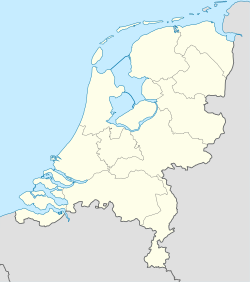Top Qs
Timeline
Chat
Perspective
2022 FIVB Women's Volleyball World Championship
International volleyball competition From Wikipedia, the free encyclopedia
Remove ads
The 2022 FIVB Women's Volleyball World Championship was the 19th staging of the FIVB Women's Volleyball World Championship, contested by the senior women's national teams of the members of the Fédération Internationale de Volleyball (FIVB). The Netherlands and Poland were dual hosts for this event.[1]
Serbia won their second title for the consecutive edition, beating Brazil in straight sets.[2] Italy took the bronze medal defeating USA.[3] Tijana Bošković was again the recipient of the MVP award of the tournament.[4]
Remove ads
Host selection
On 19 January 2019, FIVB announced that Netherlands and Poland were selected as dual hosts for this event. It is the first time that the women's World Championship has been hosted by two countries.[5]
Qualification
Summarize
Perspective
The host countries Netherlands and Poland automatically qualified for the competition as well as the current world champions Serbia. The top two teams from each of the 2021 Continental Championships secured qualification. The final 11 places belonged to top 11 teams as per FIVB World Ranking who had not yet qualified.[6]
On 1 March 2022, FIVB declared Russia and Belarus ineligible to compete in international and continental competitions due to the 2022 Russian invasion of Ukraine. As a result, Russia were out of the championship.[7] After Russia was removed from the competition, Croatia was invited to compete as the next highest ranked team in the World Ranking.[8][9]
- Notes
- a Competed as SFR Yugoslavia in 1978 (1 time) and as Serbia and Montenegro in 2006 (1 time); 3 appearances as Serbia.
- b Competed as Soviet Union from 1952 to 1990 (10 times); 7 appearances as Russia. Russia was suspended to compete under it national title due to violating WADA regulation. Later, the team was removed from all FIVB and continental competitions due to 2022 Russian invasion of Ukraine.
- c Competed as East Germany from 1956 to 1990 (7 times) and as West Germany from 1956 to 1990 (8 times); 7 appearances as Germany.
- d Competed as Czechoslovakia from 1952 to 1986 (8 times); 3 appearances as Czech Republic.
- e Turkey qualified from the continental championship due to the runners-up, Serbia, have qualified as defending champions.
- f 2021 Asian Championship was cancelled, The continental spots decided by AVC ranking.
Remove ads
Squads
Venues
Remove ads
Format
First round
In the first round, the 24 teams were spread across four pools of six teams playing in a round-robin system. The top four teams from each pool advanced to the second round.[11]
Second round
In the second round, the 16 teams were allocated in two pools of eight teams (top teams from first round pools A and D in one and top teams from pools B and C in the other). Once again a round-robin system was used in each pool, teams coming from the same first round pool (therefore already played each other) only played against opponents from a different first round pool. The second round standings took the results in the first and second rounds into account. The top four teams of each group advanced to the final round.
Final round
The top four teams of each pool played in quarterfinals. The winners advanced to semifinals. The semifinals winners advanced to compete for the World Championship title. The losers faced each other in the third place match.
Remove ads
Pools composition
Summarize
Perspective
First round
Teams were seeded in the first two positions of each pool following the Serpentine system according to their FIVB World Ranking as per end of 2021. FIVB reserved the right to seed the hosts as heads of pool A and B. The better ranked hosted team (10) allocated to pool A, and another team (12) allocated to pool B. All teams not seeded were drawn to take other available positions in the remaining lines following the World Ranking.[12]
- Draw
Second round
Remove ads
Pool standing procedure
- Total number of victories (matches won, matches lost)
- In the event of a tie, the following first tiebreaker will apply: The teams will be ranked by the most point gained per match as follows:
- Match won 3–0 or 3–1: 3 points for the winner, 0 points for the loser
- Match won 3–2: 2 points for the winner, 1 point for the loser
- Match forfeited: 3 points for the winner, 0 points (0–25, 0–25, 0–25) for the loser
- If teams are still tied after examining the number of victories and points gained, then the FIVB will examine the results in order to break the tie in the following order:
- Set quotient: if two or more teams are tied on the number of points gained, they will be ranked by the quotient resulting from the division of the number of all set won by the number of all sets lost.
- Points quotient: if the tie persists based on the set quotient, the teams will be ranked by the quotient resulting from the division of all points scored by the total of points lost during all sets.
- If the tie persists based on the point quotient, the tie will be broken based on the team that won the match of the Round Robin Phase between the tied teams. When the tie in point quotient is between three or more teams, these teams ranked taking into consideration only the matches involving the teams in question.
Remove ads
First round
- All times are Central European Summer Time (UTC+02:00).
- The top four teams in each pool qualified for the second phase.[13]
Pool A
Source: FIVB
Pool B
Source: FIVB
Pool C
Source: FIVB
Pool D
Source: FIVB
Remove ads
Second round
- All times are Central European Summer Time (UTC+02:00).
- The top four teams qualified for the final phase.[13]
- The results of all the matches in the first round were taken into account for this round.[13]
Pool E
Source: FIVB
Pool F
Source: FIVB
Remove ads
Final round
- All times are Central European Summer Time (UTC+02:00).
| Quarterfinals | Semifinals | Final | ||||||||
| 11 October – Apeldoorn | ||||||||||
1E | 3 | |||||||||
| 13 October – Apeldoorn | ||||||||||
4E | 1 | |||||||||
| 1 | ||||||||||
| 11 October – Apeldoorn | ||||||||||
| 3 | ||||||||||
2E | 3 | |||||||||
| 15 October – Apeldoorn | ||||||||||
3E | 2 | |||||||||
| 0 | ||||||||||
| 11 October – Gliwice | ||||||||||
| 3 | ||||||||||
1F | 3 | |||||||||
| 12 October – Gliwice | ||||||||||
4F | 2 | |||||||||
| 3 | ||||||||||
| 11 October – Gliwice | ||||||||||
| 1 | 3rd place match | |||||||||
2F | 3 | |||||||||
| 15 October – Apeldoorn | ||||||||||
3F | 0 | |||||||||
| 3 | ||||||||||
| 0 | ||||||||||
Quarterfinals
Semifinals
3rd place match
Final
Remove ads
Final standing
Remove ads
Awards
- Most valuable player
 Tijana Bošković (SRB)
Tijana Bošković (SRB)
- Best setter
 Bojana Drča (SRB)
Bojana Drča (SRB)
- Best outside spikers
 Gabriela Guimarães (BRA)
Gabriela Guimarães (BRA) Miriam Sylla (ITA)
Miriam Sylla (ITA)
- Best opposite spiker
 Tijana Bošković (SRB)
Tijana Bošković (SRB)
- Best middle blockers
 Ana Carolina da Silva (BRA)
Ana Carolina da Silva (BRA) Anna Danesi (ITA)
Anna Danesi (ITA)
- Best libero
 Teodora Pušić (SRB)
Teodora Pušić (SRB)
Statistics leaders
Summarize
Perspective
Statistics leaders correct as of final round.[14]
See also
Notes
- The event in Arnhem had three volleyball courts installed inside the stadium, allowing three games to be played simultaneously in the first days of competition (where all participating countries were concentrated until September 26, 2022).[10]
References
External links
Wikiwand - on
Seamless Wikipedia browsing. On steroids.
Remove ads









